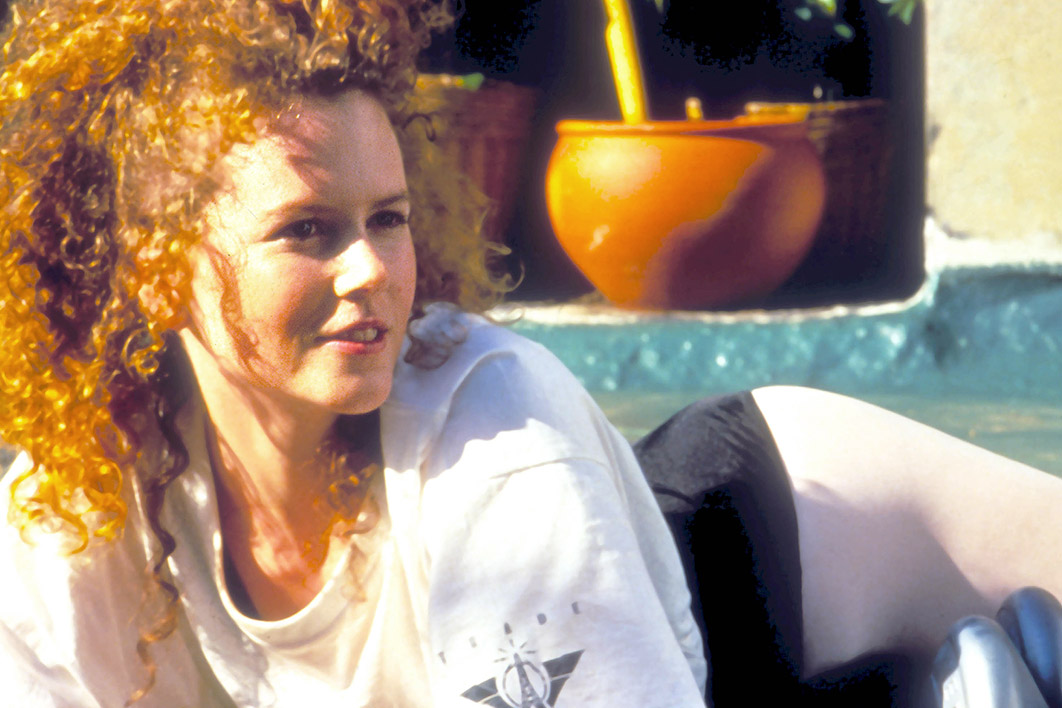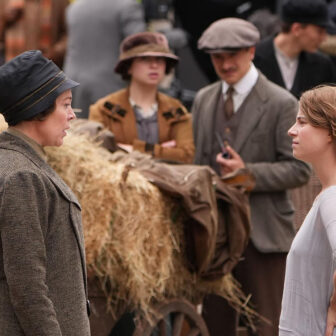Sam Twyford-Moore was transfixed when he visited Russell Crowe’s bizarre “Divorce” auction at Sydney’s Carriageworks in 2018. Gazing at a leather jockstrap Crowe wore in Cinderella Man (2005) — which went for $1840 — and the costume Errol Flynn wore in his 1948 hit Robin Hood — which was turned in — he asked himself, “Is there some sort of psychic gangway between Sydney and Los Angeles, Sydney and Hollywood?”
The answer, of course, is yes. Australians have always been “unsettled settlers,” to use historian Jill Julius Matthews’s term; and the mind maps of our theatrical people have, from the beginning of European settlement, ranged widely through the English-speaking world.
Australians were present at the birth of the American movie industry, when D.W. Griffith began filming in the small village of Hollywood. They have remained a constant part of its history as stars, bit players, directors, cinematographers… in fact, in every aspect of filmmaking. At the same time they have struggled to develop and support an industry at home, and have been pushed and pulled between these two poles by changing industry structures in Hollywood and government policies in Sydney.
In Cast Mates: Australian Actors in Hollywood and at Home, Twyford-Moore ambitiously sets out to tell the story of this troubled relationship from the 1930s to the present through the stories of four Australian actors who made their mark in the world of Hollywood: Errol Flynn, Peter Finch, David Gulpilil and Nicole Kidman. Each chapter — and life story — illustrates a moment in the attraction between Australia and Hollywood.
Errol Flynn (1909–1959) and Peter Finch (1916–1977) represent the long period, from the 1930s to the 1960s, when Hollywood, trailed by Britain, could command the world’s best talents. This was the time when local moviemakers such as Charles Chauvel and Ken Hall saw their discoveries lured away and built up into world stars by the superior moviemaking machines of Classical Hollywood. David Gulpilil (1953–2021) is a brilliant choice as a representative of the golden period of Australian filmmaking, from the late 1960s to the mid 1980s, illustrating its failure to nurture an amazing Indigenous talent.
The fourth, Nicole Kidman (born 1967) is the poster child of the period from the early 1990s, when Australian stars like Russell Crowe and Cate Blanchett have been able to remain Australian, moving between their native country and Hollywood, controlling their own lives and careers in a way that was not possible when the Hollywood machine was all-powerful.
Don’t look in Cast Mates for any clear argument about the “gangway between Sydney and Los Angeles, Sydney and Hollywood,” whether psychic or economic. Twyford-Moore is a storyteller rather than an analyst; and he is a very good one. We get no exposition of how Classical Hollywood exerted its control over world moviemaking, or the various schemes by which Australia attempted to battle against that control. This account of the industry emerges instead from the careers of the four main characters and the many cast mates Twyford-Moore showcases along the way, including Judith Anderson, Diane Cilento, Paul Hogan, Brian Syron and Cate Blanchett.
We learn, for instance, that Errol Flynn’s Hollywood career began in a British “quota quickie” in the years when the rest of the world was trying to fight the domination of Hollywood. We learn that young Peter Finch’s career in Australia during the war years was stymied by local representatives of Hollywood studios who preferred more traditionally handsome heroes. During the fifties, when production by Australian studios had virtually ceased, he returned to Australia from England to play in The Shiralee (1957) for Ealing Studios and Robbery Under Arms (1957) for Rank. (Interestingly, that iconic Australian movie, A Town Like Alice, was mainly filmed in England.)
Later, with Old Hollywood dead, Finch’s rugged, world-weary face was perfect for the part of Howard Beale, the NBC newscaster who spectacularly melted down on air, shouting he was “mad as hell.” After building a career despite Hollywood, he was sought out by Hollywood and rewarded with its highest accolade, an Academy Award. Alas, too late: it had to be awarded posthumously.
Although we learn much about the structures within which these Australian stars made their careers, the true richness of Cast Mates is in the telling of their life stories. These are fascinating people drawn towards a certain cosmopolitanism by virtue of birth, upbringing or temperament.
Errol Flynn’s parents were temporary Australians who returned to their native Ireland in retirement. Peter Finch became an Australian at the age of ten after an extraordinary early childhood of abandonment and displacement. David Gulpilil was an Indigenous Australian moving between a remote community and modern white urban life. Nicole Kidman, daughter of an Australian father studying abroad, was born in Hawaii and spent her early years in the United States. With the pale skin of a redhead, she chose reading, theatre and movies over Sydney’s beach culture.
Twyford-Moore tells these life stories with a density of striking detail that can be exhausting; but it is this detail that makes the book. David Gulpilil’s chapter is a case in point. He was a fifteen-year-old schoolboy and sometime stockman at Maningrida, 500 kilometres east of Darwin, when he was chosen for his part in Nicolas Roeg’s Walkabout (1971). He had won a dance competition at the Darwin Eistedfodd and was recommended for the role by the director of welfare for the Northern Territory administration, to whom he wrote of his adventures during the world tour organised by the film’s US distributor, Twentieth Century Fox. He became a good friend of Dennis Hopper (whom he decribes as “fucking crazy”) during the shooting of Mad Dog Morgan (1976). He had a meeting with Clint Eastwood about a possible collaboration that came to nothing.
In a long, sad, discussion of movies never made, Twyford-Moore gives details of an early, rarely seen documentary, Walkabout to Hollywood (early eighties) — in which Gulpilil visits Disneyland with his young family and tries on cowboy boots — made by Bill Leimbach, who had wanted Gulpilil for a movie (never made) that he wrote about Governor Phillip and Bennelong.
Worth the book’s price alone is the section on Biripi actor and director Brian Syron, whose Kicking Down the Doors: A History of First Nation Films 1968–1993 is, for Twyford-Moore, “a wildfire of condemnation” of the Australian film industry. “The paucity of Australian films through the twentieth century,” he writes, “can make Australia look like a victim — hurt by the impositions of Hollywood — but it was a perpetrator too.”
This is a book written by a fan — a very intelligent and hardworking one — and Twyford-Moore lavishes his greatest love on his final subject, Nicole Kidman. Her story is almost as extraordinary as David Gulpilil’s. A very tall schoolgirl, fourteen years old, with pale skin and a mop of unruly red hair, she was noticed in 1983 by Jane Campion, then at the Australian Film and Television School, who had wanted her for her final student film, A Girl’s Own Story. But others also saw her potential: Storm Boy’s director, Henri Safran, cast her in his remake of the Australian classic Bush Christmas, and Brian Trenchard-Smith starred her in the wonderful Sydney Harbour chase movie BMX Bandits that same year.
Kidman emerged as a beauty in David Williamson’s Emerald City in 1988, her hair somewhat tamed but still spectacular. The following year she made her breakthrough film, Dead Calm, produced by George Miller and directed by Phillip Noyce. (You have to read the book for the long story of how they secured the rights from Orson Welles’s widow.) This led to her signing, at twenty-two, with Hollywood “superagent” Sam Cohn, and being chosen by Tom Cruise as his love interest in Days of Thunder (1990), described by one Australian journalist as “a ninety-minute first date for Tom Cruise and Nicole Kidman.”
We know the rest of the story — the marriage to Cruise; her American breakthrough role in To Die For (1995); Stanley Kubrick’s erotic Eyes Wide Shut (1999); her collaborations with fellow Australian Baz Luhrmann, Moulin Rouge! (2001) and Australia (2008); her marriage to Australian singer Keith Urban; her emergence as a producer of independent films such as Rabbit Hole (2010)oleb Hole (2010).HH and successful TV series such as Big Little Lies (2017–19); her life divided between Nashville (not Hollywood) and Sydney. Twyford-Moore fills this out with a plethora of delicious and informative background stories, from Matthew McConaughey’s five months in Gorokan High (the same “shithole public school” on NSW’s Central Coast that Twyford-Moore attended) and Stanley Kubrick’s love of the telephone and the fax.
This is a fascinating book to dip into in short, intense bursts. Its stories will delight you, instruct you, make you furiously angry, make you laugh out loud. Above all it will send you back to the movies these Australian stars made. It will also lead you to read it with Google open by your side, to follow Twyford-Moore even further down some rabbit hole or to get a timeline on the various government policies or changes in the movie industry. You will come away entertained and educated. There is an excellent index, an absolute necessity for any biographical publication, but no illustrations. Not a good decision, NewSouth!
Sam Twyford-Moore’s skills as a biographer are clearly demonstrated in Cast Mates. I predict that his next book will focus on one intriguing individual: perhaps someone from Australia’s new success story, Indigenous filmmaking — Rachel Perkins, Aaron Pedersen or Warwick Thornton — or the multicultural actors and filmmakers he features in his epilogue — Bina Bhattacharya, Geraldine Viswanathan and Arka Das. Whomever he chooses to write about, I look forward to another delicious read. •
Cast Mates: Australian Actors in Hollywood and at Home
By Sam Twyford-Moore | NewSouth | $34.99 | 306 pages




